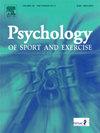Sampling perception-action couplings from competition create representative basketball shooting tasks: A replication and extension of Gorman and Maloney (2016)
IF 3.1
2区 心理学
Q2 HOSPITALITY, LEISURE, SPORT & TOURISM
引用次数: 0
Abstract
Designing representative learning tasks requires a theoretically informed sampling of key performer-environment interactions. This study sampled the constraints from basketball to create a representative environment by examining the effect of a defender on the shooting performance of skilled female basketballers. Participants performed a one-on-one defended shooting task and an undefended shooting task. Temporal variables were recorded during each shooting task, and a sample of the cohort completed a focus group to gain qualitative insights into each testing condition. Results found that the defended condition caused a decrease in shooting accuracy and shot execution time, with an increase in ball flight time and jump time compared to the undefended condition. Within-subject variability increased in the defended condition for jump time and shot execution time, suggesting that the presence of the defender prompted players to change their movements. Shooting accuracy in the defended condition showed a high correlation to the shooting accuracy exhibited in competition statistics. Qualitative data revealed three themes; affective-cognitive response, sampling to design representative practice tasks, and shooting as an adaptive skill. Introducing a defender into a shooting practice task created a more representative activity that influenced the players’ shooting technique and accuracy. The players adapted to the presence of a defender by executing their shot faster, increasing jump time, and increasing the flight time of the ball. Sampling key performance constraints to create defended situations may encourage a more adaptable technique, resulting in greater skill transfer from training to in-game performance.
从比赛中取样感知-动作耦合创造具有代表性的篮球投篮任务:复制和扩展。
设计具有代表性的学习任务需要对关键执行者与环境的相互作用进行理论上知情的采样。本研究以篮球运动为研究对象,通过考察防守球员对熟练女子篮球运动员投篮表现的影响,从而形成具有代表性的环境。参与者进行了一对一的防守投篮任务和无防守投篮任务。在每次射击任务期间记录时间变量,并对队列样本进行焦点小组调查,以获得对每个测试条件的定性见解。结果发现,防守状态下投篮精度和投篮执行时间下降,球的飞球时间和跳球时间比不防守状态下增加。在防守条件下,跳跃时间和投篮执行时间的受试者内部变异性增加,这表明防守者的存在促使球员改变他们的动作。防守状态下的射击精度与比赛统计中显示的射击精度呈高度相关。定性数据揭示了三个主题;情感认知反应,抽样设计具有代表性的练习任务,以及射击作为一种适应性技能。在射门练习任务中引入一名后卫,创造了一个更具代表性的活动,影响了球员的射门技术和准确性。球员们通过加快投篮速度、增加起跳时间和增加球的飞行时间来适应防守者的存在。采样关键性能约束来创造防守情境可能会鼓励更强的适应性技术,从而使更多的技能从训练转移到游戏中的表现。
本文章由计算机程序翻译,如有差异,请以英文原文为准。
求助全文
约1分钟内获得全文
求助全文
来源期刊
CiteScore
6.40
自引率
5.90%
发文量
172
审稿时长
69 days
期刊介绍:
Psychology of Sport and Exercise is an international forum for scholarly reports in the psychology of sport and exercise, broadly defined. The journal is open to the use of diverse methodological approaches. Manuscripts that will be considered for publication will present results from high quality empirical research, systematic reviews, meta-analyses, commentaries concerning already published PSE papers or topics of general interest for PSE readers, protocol papers for trials, and reports of professional practice (which will need to demonstrate academic rigour and go beyond mere description). The CONSORT guidelines consort-statement need to be followed for protocol papers for trials; authors should present a flow diagramme and attach with their cover letter the CONSORT checklist. For meta-analysis, the PRISMA prisma-statement guidelines should be followed; authors should present a flow diagramme and attach with their cover letter the PRISMA checklist. For systematic reviews it is recommended that the PRISMA guidelines are followed, although it is not compulsory. Authors interested in submitting replications of published studies need to contact the Editors-in-Chief before they start their replication. We are not interested in manuscripts that aim to test the psychometric properties of an existing scale from English to another language, unless new validation methods are used which address previously unanswered research questions.

 求助内容:
求助内容: 应助结果提醒方式:
应助结果提醒方式:


